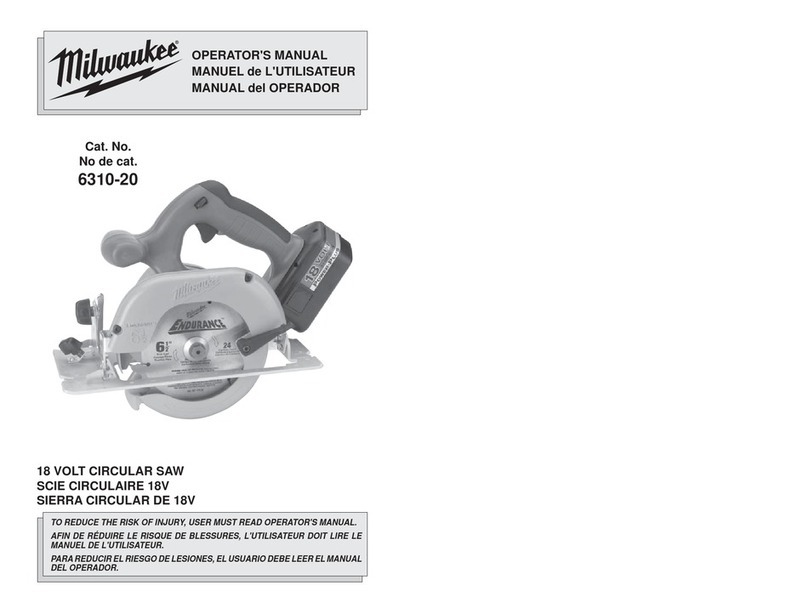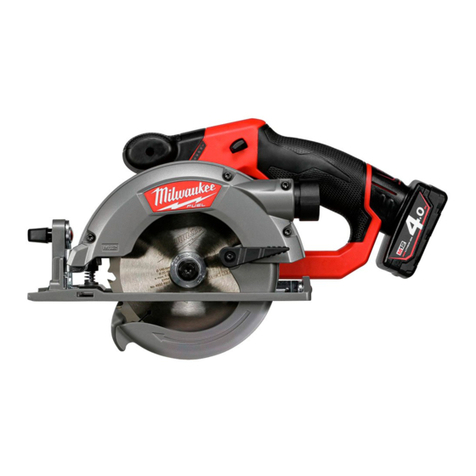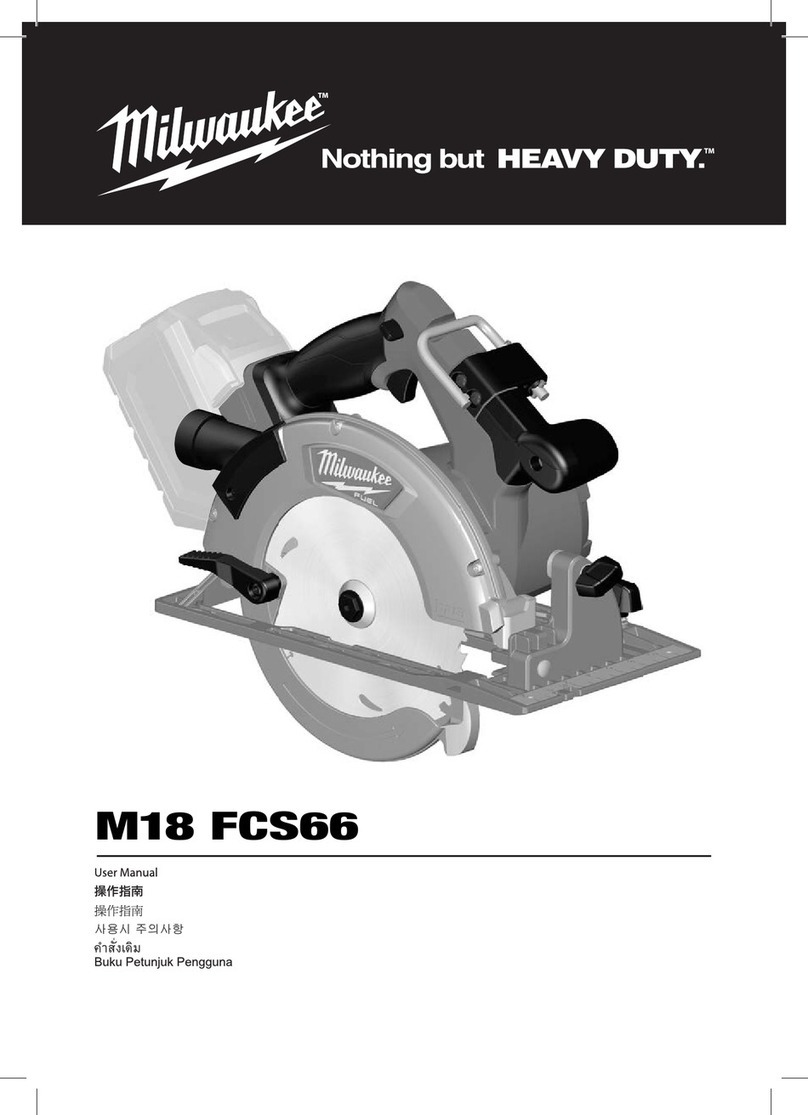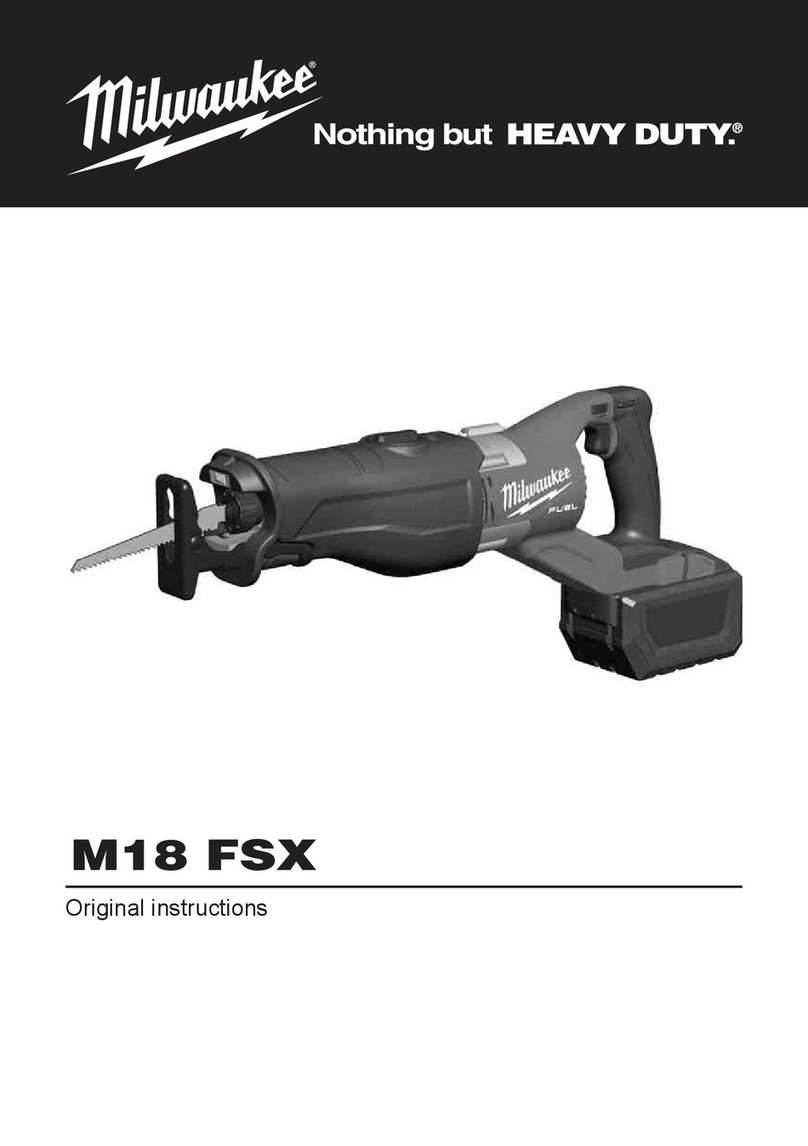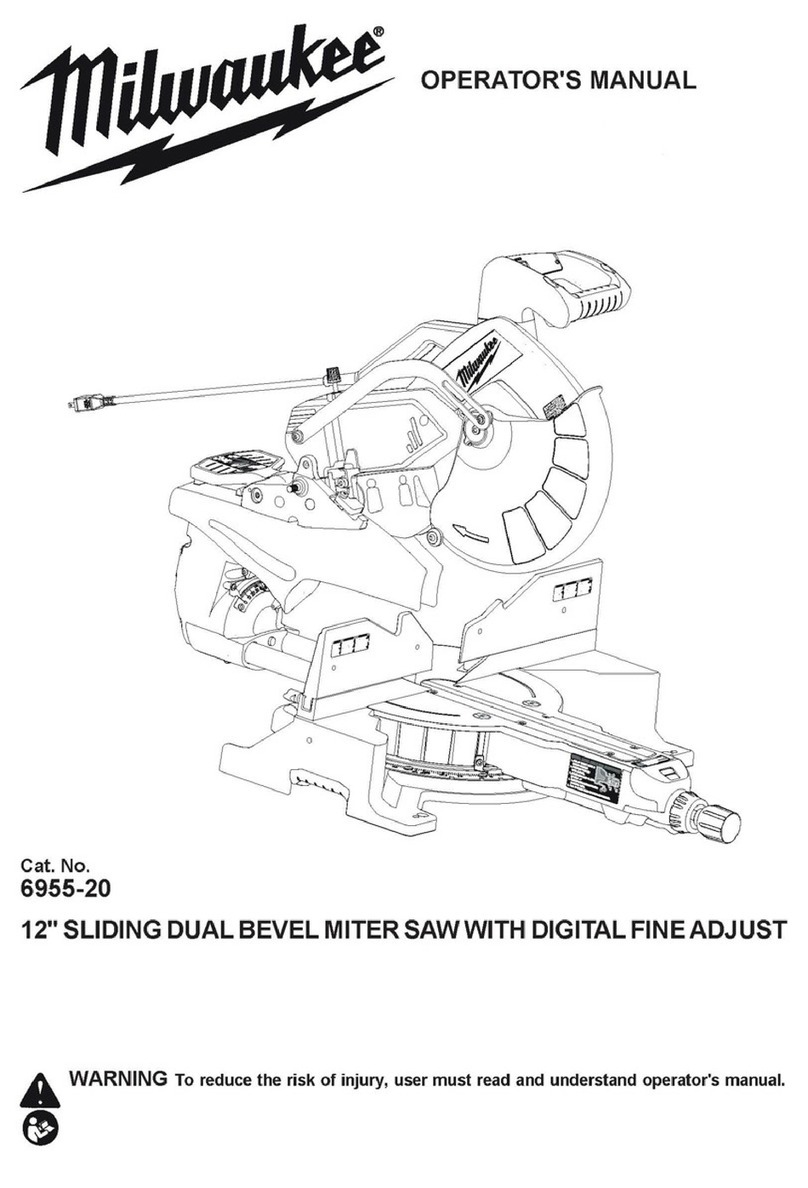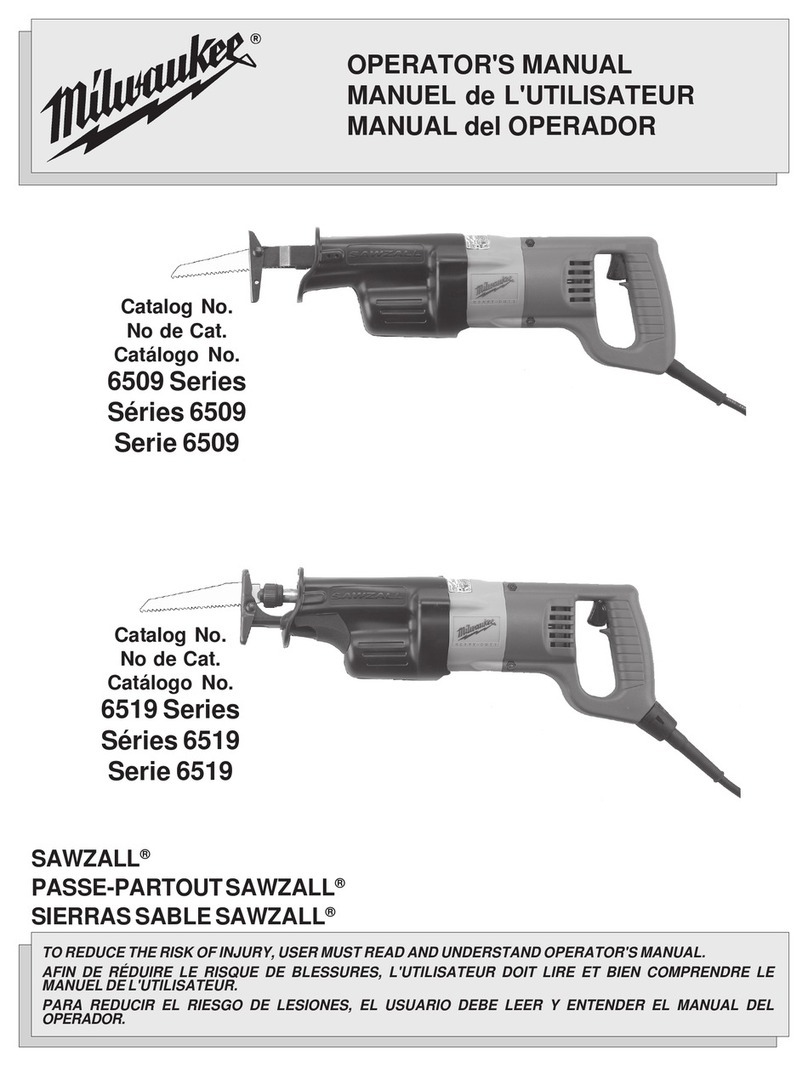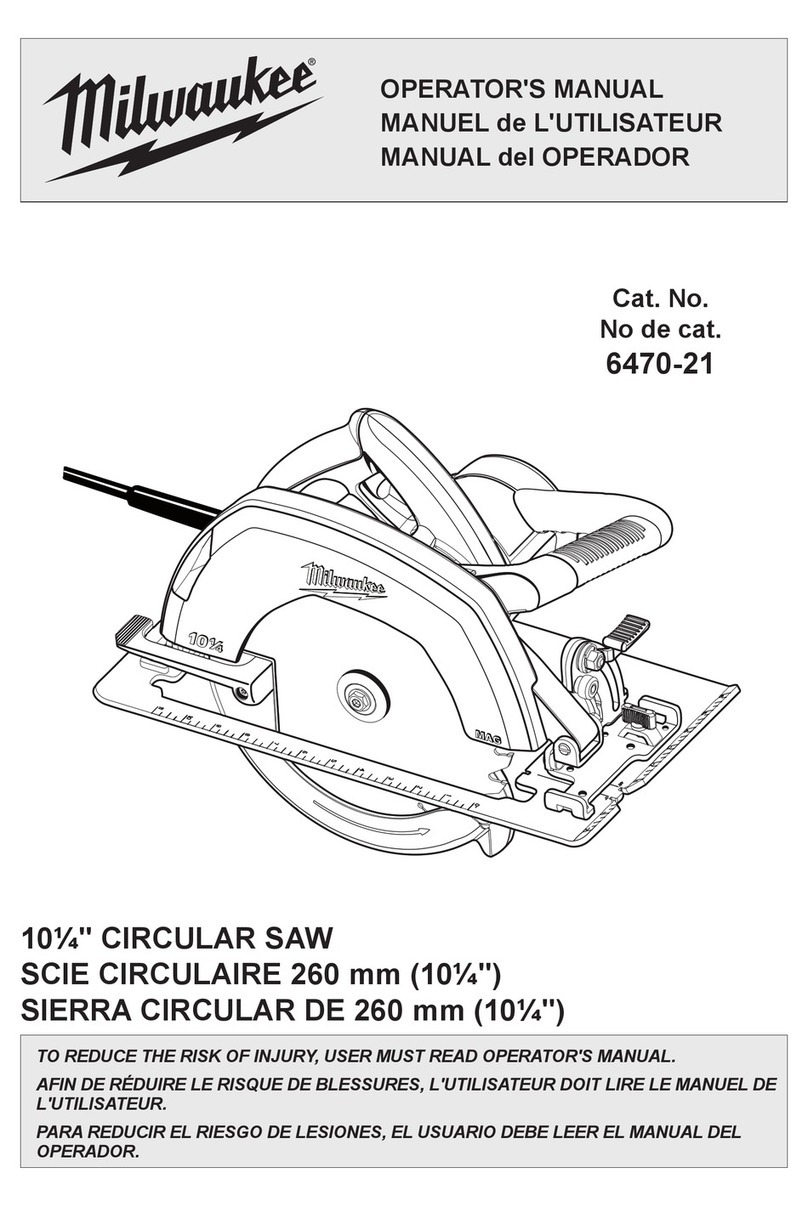12 13
SÉCURITÉ DU LIEU
DE TRAVAIL
AVERTISSEMENT
LIRE SOIGNEUSEMENT TOUTES LES INSTRUCTIONS
Le non respect des instructions ci-après peut entraîner des chocs électriques, des
incendies et/ou des blessures graves. Le terme «outil électrique» figurant dans les
avertissements ci-dessous renvoie à l’outil électrique à alimentation par le réseau
(à cordon) ou par batterie (sans fil).
CONSERVER CES INSTRUCTIONS
RÈGLES GÉNÉRALES DE SÉCURITÉ POUR LES OUTILS
ALIMENTÉS PAR BATTERIE
1. Maintenirlazone detravail propreet bien
éclairée. Les zones encombrées ou mal
éclairées sont favorables aux accidents.
2. Ne pas utiliser d’outil électrique dans
une atmosphère explosive, telle
qu’en en présence de liquides, de
gaz ou de poussières inflammables.
Les outils électriques génèrent des
étincelles qui peuvent enflammer les
poussières ou les fumées.
3. Tenir les enfants et les personnes
non autorisées à l’écart pendant le
fonctionnement d’un outil électrique.
Unmanqued’attentiondel’opérateurrisque
de lui faire perdre le contrôle de l’outil.
4. La fiche de l’outil électrique doit cor-
respondre à la prise d’alimentation.
Ne jamais modifier la fiche d’une
manière quelconque. Ne pas utiliser
d’adaptateur avec les outils élec-
triques mis à la terre (à la masse).
Des fiches non modifiées et des prises
d’alimentation assorties réduisent le
risque de choc électrique.
5. Éviter tout contact corporel avec des
surfaces reliées à la masse ou à la
terre telles que tuyaux, radiateurs,
cuisinièreset réfrigérateurs.Un risque
de choc électrique plus élevé existe si le
corps est relié à la masse ou à la terre.
6. Ne pas exposer les outils électriques
à la pluie ou à l’humidité. Le risque de
choc électrique augmente si de l’eau
s’infiltre dans un outil électrique.
9. Être sur ses gardes, être attentif et
faire preuve de bon sens en utilisant
un outil électrique. Ne pas utiliser
un outil électrique en cas de fatigue
ou sous l’influence de drogues,
d’alcool ou de médicaments. Un
instant d’inattention lors de l’utilisation
d’un outil électrique peut entraîner des
blessures graves.
10. Utiliser un équipement de sécurité.
Toujours porter des lunettes de pro-
tection. Un équipement de sécurité
comprenant masque anti-poussière,
chaussuresde sécuritéanti-dérapantes,
casque ou dispositif de protection anti-
bruitpeut, dansles circonstancesappro-
priées, réduire le risque de blessure.
11. Éviter tout démarrage accidentel de
l’outil. S’assurer que le commutateur
est en position OFF (Arrêt) avant de
brancher l’outil. Le port de l’outil avec
un doigt sur le commutateur ou son
branchement avec le commutateur en
position ON (Marche) sont favorables
aux accidents.
7. Prendre soin du cordon. Ne jamais
utiliser le cordon pour transporter,
tirer ou débrancher l’outil électrique.
Tenir le cordon à l’écart de la chaleur,
des huiles, des arêtes coupantes ou
des pièces en mouvement. Uncordon
endommagé ou emmêlé présente un
risque accru de choc électrique.
8. Se procurer un cordond’alimentation
approprié en cas d’utilisation
d’un outil électrique à l’extérieur.
L’utilisation d’un cordon d’alimentation
pour usage extérieur réduit le risque de
choc électrique.
SÉCURITÉ INDIVIDUELLE
SÉCURITÉ ÉLECTRIQUE
UTILISATION ET ENTRETIEN
DE L’OUTIL ÉLECTRIQUE
16. Ne pas forcer l’outil électrique.
Utiliser l’outil électrique approprié
à l’application considérée. L’outil
électrique adapté au projet considéré
produira de meilleurs résultats, dans
desconditionsde sécurité meilleures,à
la vitesse pour laquelle il a été conçu.
17. Ne pas utiliser l’outil électrique si le
commutateur ne le met pas sous ou
hors tension. Tout outil électrique dont
le commutateur de marche-arrêt est ino-
pérant est dangereux et doit être réparé.
18. Débrancher la fiche de la prise
d’alimentation et/ou la batterie de
l’outil électrique avant d’effectuerdes
réglages, de changer d’accessoires
ou de ranger l’outil. Detellesmesures
de sécurité préventive réduisent le
risque de mettre l’outil en marche ac-
cidentellement.
19. Ranger les outils électriques inutili-
sés hors de la portée des enfants et
ne pas laisser des personnes qui
connaissent mal les outils élec-
triques ou ces instructions utiliser
ces outils. Les outils électriques sont
dangereuxdansles mainsd’utilisateurs
non formés à leur usage.
20. Entretien des outils électriques.
S’assurer de l’absence de tout dés-
alignement ou de grippage des
pièces mobiles, de toute rupture de
pièce ou de toute autre condition
qui pourrait affecter le bon fonc-
tionnement de l’outil électrique. En
cas de dommages,faire réparer l’outil
avant de l’utiliser de nouveau. Les
outils électriques mal entretenus sont à
la source de nombreux accidents.
21. Garder les outils de coupe affûtés et
propres. Les outils de coupe correcte-
mententretenuset bienaffûtésrisquent
moins de se gripper et sont plus faciles
à manier.
22. Utiliser cet outil électrique, les acces-
soires, les mèches, etc. conformé-
ment à ces instructions et de la façon
prévue pour ce typeparticulier d’outil
électrique, tout en prenant en compte
les conditions de travail et le type de
projet considérés. L’utilisation de cet
outilélectriquepour un usageautre que
l’usage prévu peut créer des situations
dangereuses.
UTILISATION ET ENTRETIEN
DE LA BATTERIE
23. S’assurer que le commutateur est en
position OFF (Arrêt) avantd’insérer la
batterie. L’insertion de la batterie dans
un outil électrique dont le commutateur
est en position ON (Marche) est favor-
able aux accidents.
24. Ne recharger la batterie qu’avec le
chargeur spécifié par le fabricant.
Un chargeur qui convient à un type de
batterie peut créer un risque d’incendie
s’il est utilisé avec un autre type de bat-
terie.
25. N’utiliser les outils électriques
qu’avec les batteries spécialement
conçues pour eux. L’utilisation de
batteries d’autres marques peut créer
un risque de blessure et d’incendie.
26. Lorsque la batterie est hors service,
la ranger à l’écart d’autres objets mé-
talliques tels que trombones, pièces
de monnaie, clés, clous, vis et autres
petits objets métalliques qui peuvent
établir une connexion d’une borne à
l’autre. Un court-circuit aux bornes de
la batterie peut provoquer des brûlures
ou un incendie.
12. Retirer toute clé de réglage avant de
mettre l’outil sous tension. Une clé
laissée attachée sur une pièce mobile
de l’outil électrique peut entraîner des
blessures.
13. Ne pas travailler à bout de bras. Bien
garderun bon équilibre à toutinstant.
Ceci permet de mieux préserver la
maîtrise de l’outil électrique dans des
situations imprévues.
14. Porter des vêtements adéquats. Ne
pas porter de vêtements amples
ni de bijoux. Ne pas approcher les
cheveux, vêtements et gants des
pièces en mouvement. Lesvêtements
amples,lesbijoux ou lescheveux longs
risquentd’êtrehappés parles pièces en
mouvement.
15. Si des dispositifs sont prévus pour
l’extraction et la récupération des
poussières, vérifier qu’ils sont con-
nectés et utilisés correctement.
L’utilisation decesdispositifs peutrédu-
ire les risques liés aux poussières.


